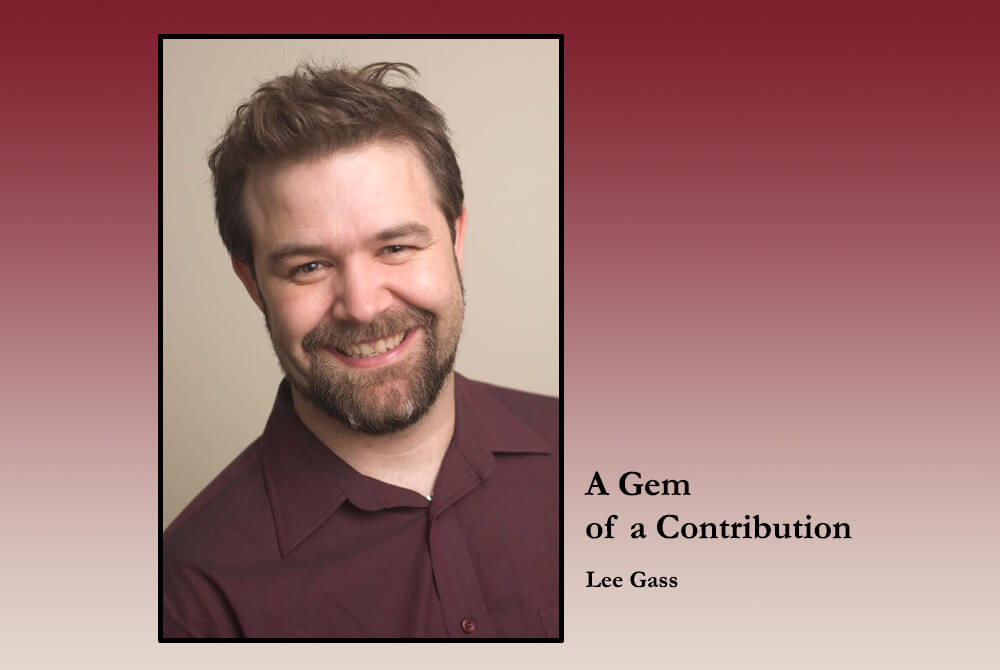A Gem of a Contribution
A precious,
gem-like event occurred in a
workshop Arshad Ahmad and I ran
for postsecondary educators on
large-group teaching.
Rather than
talk at participants about
what we had read, thought about, or
done, we mined their experience instead
and helped them understand
and appreciate it.
We suggested
that many challenges in teaching
might not be basic in their own right, but
symptoms of deeper, more basic challenges.
If so, we argued, then meeting a few basics
might ease whole sets of difficulties and
make things work better for
students and teachers.
With no
more basis than that,
we invited them to tell us
about basic challenges of
working with large
groups.
The very first
response was from one of
six graduate students in the group,
Brett Gilley, from Simon Fraser University,
and it was a real gem. Not only did he identify
one of the more basic issues of all, but the
teachable moment his comment set up
structured that workshop and
spilled far beyond it.
Here is the story
of Brett’s suggestion
and how it has influenced
my teaching since.
He suggested that
one of the greater challenges in
teaching is to create a kind of feeling
or atmosphere in a room in which learning
is safe, fun, exciting, deep, fast, and lasting. When the
feeling is in the room, problems fall away and our chal-
lenge, if we can even think of it as that, is to stay out of
students’ way and let them learn. With it, our work
is easy and thrilling. Without it, barriers are
everywhere and teaching is
hard work.
Brett argued
that for many kinds of reasons,
the feeling is easier to achieve in small
groups but can happen in large groups too.
Teaching large classes is easier with than
without the feeling, and is more fun
and effective for everyone.
Talk about teachable moments!
Largely because
of it, that workshop was by far
the most successful of four Arshad and I
ran on the same topic in various places, it
informed my keynote address two days
later and helped me understand
what I heard in talks.
Several
other interesting
things happened that week,
each of them related to
Brett’s suggestion.
Here are the short versions
of those stories.
First, I attended
a workshop on passion in
and for teaching, led by 3M National
Teaching Fellow Clarissa Green, where we
discussed how sources of passion in our
own work make the miracle that
some of us sustain it for
entire careers.
I told how Brett had
injected passion into our workshop by
injecting an idea he was passionate about
– – – a sort of passion in the air in rooms
that empowers participants, powers
interaction, and massively
accelerates learning
rates.
Someone
commented that the
feeling could not have grown had
we not invited, nourished, protected,
and guided its development, and
we all agreed completely
with that.
Brett injected
an idea into one group
and I injected it into another.
That multiplied, not just
added to, its value.
Second, I attended a
workshop on narrative writing, led
by 3M Fellow Guy Allen. Before anyone
else had said a word, a powerful
feeling pervaded the room.
Catalyzed by Guy’s introduction,
we were in touch with Guy, in touch with
each other, and in touch with a set of notions
about ourselves. Then Guy invited us
to write our personal narratives.
What a
jolt it was to realize,
some time later, that the third
workshop embodied the essence of
the other two, which raised their
value to a higher power, and
the gifts kept giving.
Late that week,
I gave a keynote address at the
annual meeting of a large group of distance
education teachers at the now-defunct BC
Open University. This was before the
internet revolution.
Minutes in, I
knew something wasn’t
right. My words sounded hollow,
I felt inauthentic, and though people
seemed to be with me, I knew they would
drift away if something didn’t change.
The feeling wasn’t growing
in the room.
Fundamentally, I
realized, the problem was
that I was speaking from a perspective
that did not map directly enough into
the experience of my audience
and they didn’t resonate
with what I said.
I spoke from
my own experience of
working with students in class-
rooms. I needed to speak to their experience
of working with students on the phone.
What’s more, they needed to
speak about it.
I’d been shrinking
figurative distances in face to face
learning situations for decades by then
but knew nothing about teaching
at a real distance.
So I stopped,
shared Brett’s notion about
feelings in rooms, said something
might be similar of telephone talks
with students, and asked them
to tell me about it.
They did.
The feeling in
the room shifted at once.
For the next hour and a half we
explored a wide array of ways distance
education teachers establish and
maintain that feeling over
the phone.
It was
wonderful! I left with
an appreciation for the value
of distance education, a deep feeling
for the unity of the helping professions,
a renewed passion for teaching,
teachers, and students, and
a sense of hope for
us all.
Brett Gilley is now
an Associate Professor of Teaching
in Earth and Ocean Sciences and
Vantage College at UBC.
Edited May 2022


